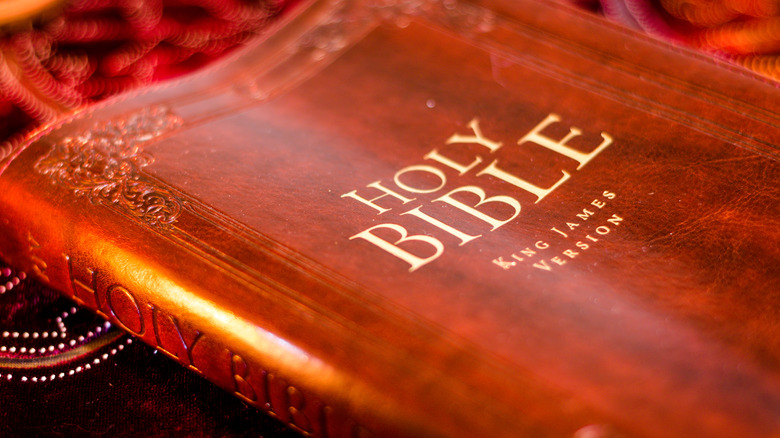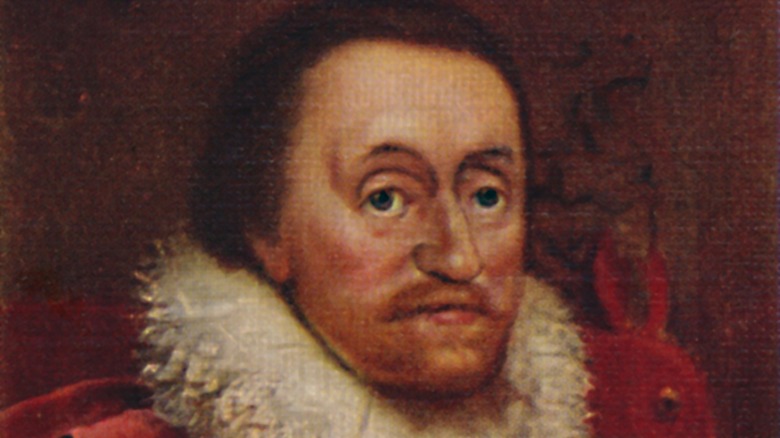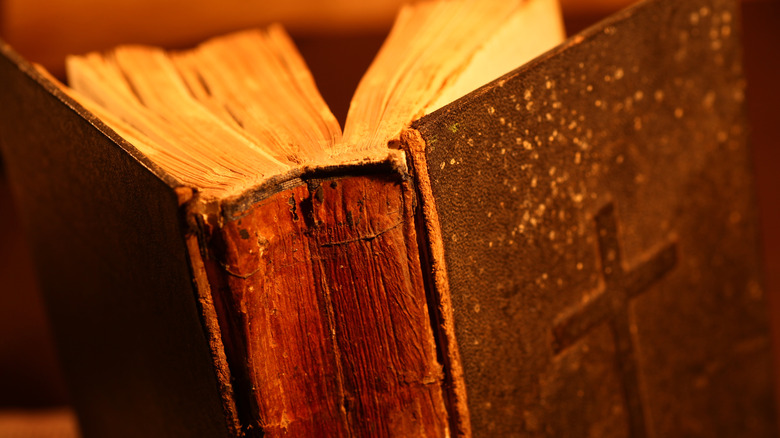The Real Reason The King James Bible Was Created
The King James Bible, sometimes called the King James Version (KJV), is one of the most revered religious texts in the world, and it's certainly one of the most popularly used by different branches of the Christian religion. According to the Christian Post, the KJV is used by Mormons, Episcopalians, Pentecostals, Presbyterians, and Baptists, among others. The Catholic Church, the most old school of all the Christian denominations, most frequently uses the New American Bible's English translation, as noted by Difference Between, though English other translations are also used. Then of course, there's the Anglican Church, who among other translations, still uses the KJV, and they have a special relationship with this particular version.
The earliest iterations of the Bible are especially old documents. As BBC points out, the Old Testament, which is also the original Jewish Bible, was written between 1200 and 165 BCE, while the New Testament came about in the first century CE. Neither of these were traditionally written in English, however. Britannica says the Old Testament was recorded primarily in ancient Hebrew while the New Testament was produced in Greek, and both had short bits written in Aramaic. Obviously, this wouldn't do for English or other European language speakers once the Christian religion made its way around the continent. They needed their own translated versions for their own churches, so the Bible was re-recorded several more times in several more places.
A crisis of translation
The 15th century saw quite the rise in Bible translations. A big part of this had to do with two things: The Protestant Reformation, when smaller churches were breaking away from the Catholic Church (via History), and the invention of the printing press in 1450. Before this, Britannica says, there were only slightly more than 30 different translations of the Bible floating around, but thanks to the hope the Protestant Reformation gave those wanting to break free of Catholicism, from the time Martin Luther published his "95 Theses" in 1517 until the end of the Thirty Years War with the 1648 Treaty of Westphalia (via History), more translations started sprouting up. Martin Luther, the OG reformer, published his own translation. There was another coming in from the Dutch humanist Erasmus. In England, according to TIME, William Tyndale's translation became the first of its kind in 1535, and it was followed shortly after by the Calvinists Bible, known as the "Geneva Bible."
The Calvinists were once present in Scotland, according to BBC, until Queen Mary, King James' mother, had them expelled. Being Catholic, she wasn't a huge fan of the Reformation and had some 250 or so Protestants killed during her time. That move didn't turn out great for her, but at least the Calvinists only got exiled to Switzerland, where they continued to print copies of their beloved book.
The real reason it was created
As you may have guessed, the King James Version of the Bible was commissioned in 1604 by King James I of England, who Britannica says reigned from 1567 to 1625. The king wasn't quite so handy as to translate the whole thing itself. To do so would've taken a command of not just one language but many, at an expert level that few people possessed. The king needed scholars, wordsmiths, people with the ability to take the ancient languages and make them ring with the people of the era, and they had to get it done quickly.
The Geneva Bible created by the Calvinists had become the most popular version of the Bible among reformers of the time, as TIME explains, and that could've been a good thing. History notes that Calvinists and the Church of England alike were reformers contending with the Catholic Church, but the Calvinists had stayed in exile for a reason. Their version of the Bible slapped back at the power of bishops and the hierarchy of Britain's church, at the head of which was the king himself (via History), and it was causing serious tension between the Protestant factions. King James got the best people he could find to put together a new version of the Bible that he hoped would resolve these tensions. Like a lot of religious history, this was a political move to help keep his subjects from quarreling and protect his own churches.
The King James Bible is born
The Geneva Bible did things like compare the plague of locusts from the Book of Exodus to the members of the Church of England who had political power, according to TIME, such as bishops and the like. It also interpreted other passages in such a way that it built disdain for the riches and rich dress of said figures. King James' churches and the political power his position as head of the Church of England afforded him were in jeopardy. The King had to find a way to put minds at rest — not to mention how too many interpretations of the same religion has been known to cause violent quarrels throughout history. Contrary to what would usually be expected of a ruler who was also a religious leader, King James didn't outlaw the Geneva Bible, as Reinhardt University explains, but instead created an authorized version to be used exclusively in churches. This how the KJV was born.
King James put 51 scholars to work, according to Britannica, headed by John Rainolds, president of Corpus Christi College. There were six different committees charged with translating different books of the new Bible, and between all them, they managed to have the new thing completed in just seven years. The new Bible they produced avoided the strict literal translations of previous versions and was instead filled with synonyms to make it more accessible to bring people together. Unfortunately, Rainolds died in 1607 and never saw the completed product.
How the KJV differs from the Catholic and other Bibles
The Bible commissioned by King James, like other Protestant Bibles, differs from that used by the Catholic Church. This was the first official church of Christianity, and as such, their version of the Bible tends to be a bit more old-school in ways. To begin with, as Difference Between points out, the Catholic Bible contains parts of the Old Testament that no other Christian Bible uses. Although when the King James Bible was first written, however, it also included these books, but the newer versions do not. Actually, the Jewish religion doesn't even use these books anymore, but the Catholic Church has decided they still have a necessary spiritual value that should be included in their holiest text. The collection that includes these books are known as the "Apocrypha." The books you'll find within are First and Second Maccabees, Judith, Tobit, Wisdom, Baruch, and Ecclesiasticus. Oddly enough, these books weren't officially part of their text until the 16th century.
When King James laid out rules for the KJV's translation, he required that all margin notes be removed, unlike the Geneva and other Bibles, as well as that the word "church" would not be converted to "congregation," as Bible Researcher explains. This was to help preserve the power of the church's authority — his authority.




